Business Management Essay: Organisational Culture and Leadership
VerifiedAdded on 2020/10/22
|9
|2558
|290
Essay
AI Summary
This essay delves into the multifaceted concept of organisational culture, exploring its essential elements such as values, beliefs, and norms, and how they contribute to the smooth functioning of an organisation. It examines the crucial role of leaders in fostering a strong organisational culture, particularly within inclusive and multinational settings, highlighting strategies for effective leadership. The essay also reflects on the organisational culture of Google, analysing how management and leaders have influenced, or failed to influence, its cultural dynamics. The study considers various leadership styles and organisational culture models like Charles Handy's, providing a comprehensive understanding of how to create and maintain a robust and effective organisational culture.
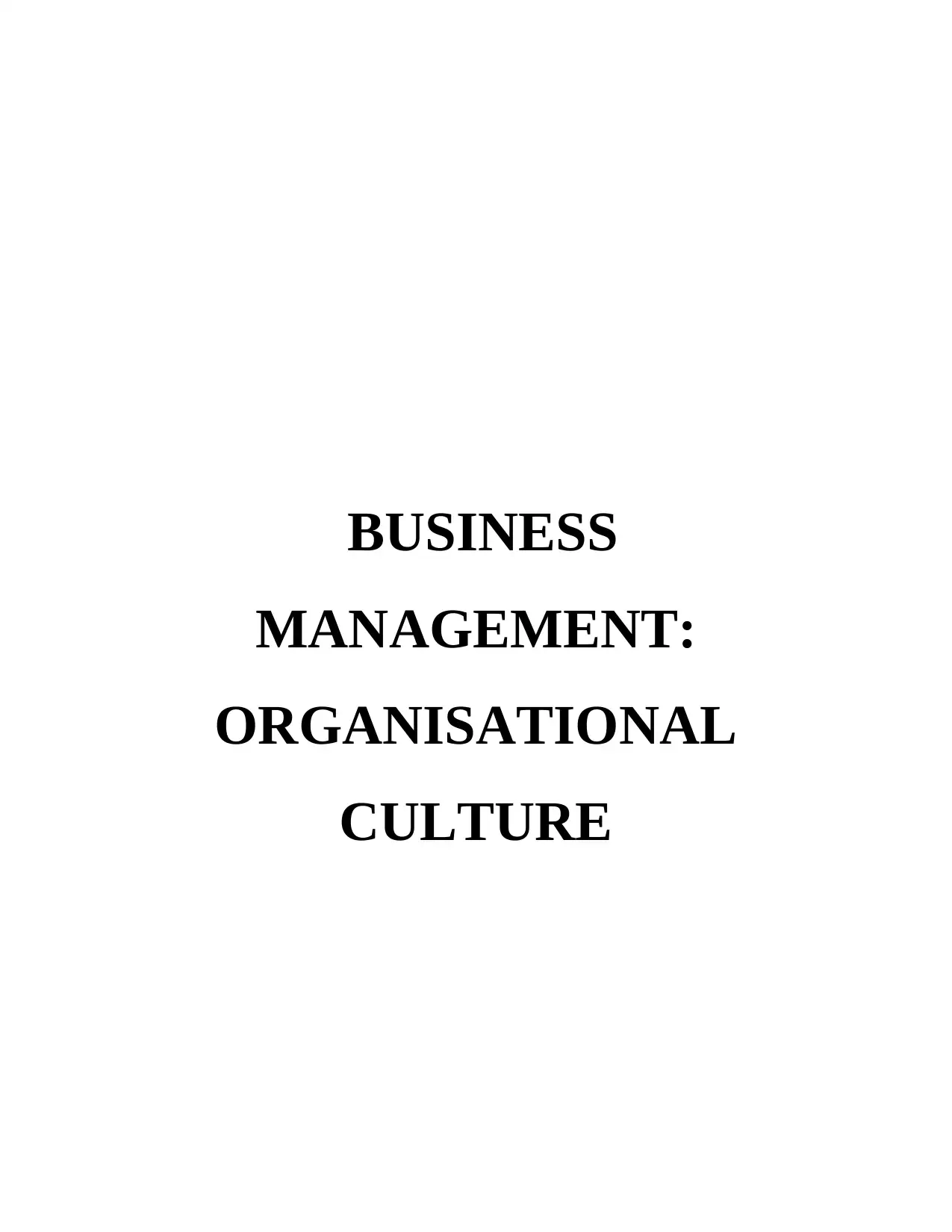
BUSINESS
MANAGEMENT:
ORGANISATIONAL
CULTURE
MANAGEMENT:
ORGANISATIONAL
CULTURE
Paraphrase This Document
Need a fresh take? Get an instant paraphrase of this document with our AI Paraphraser
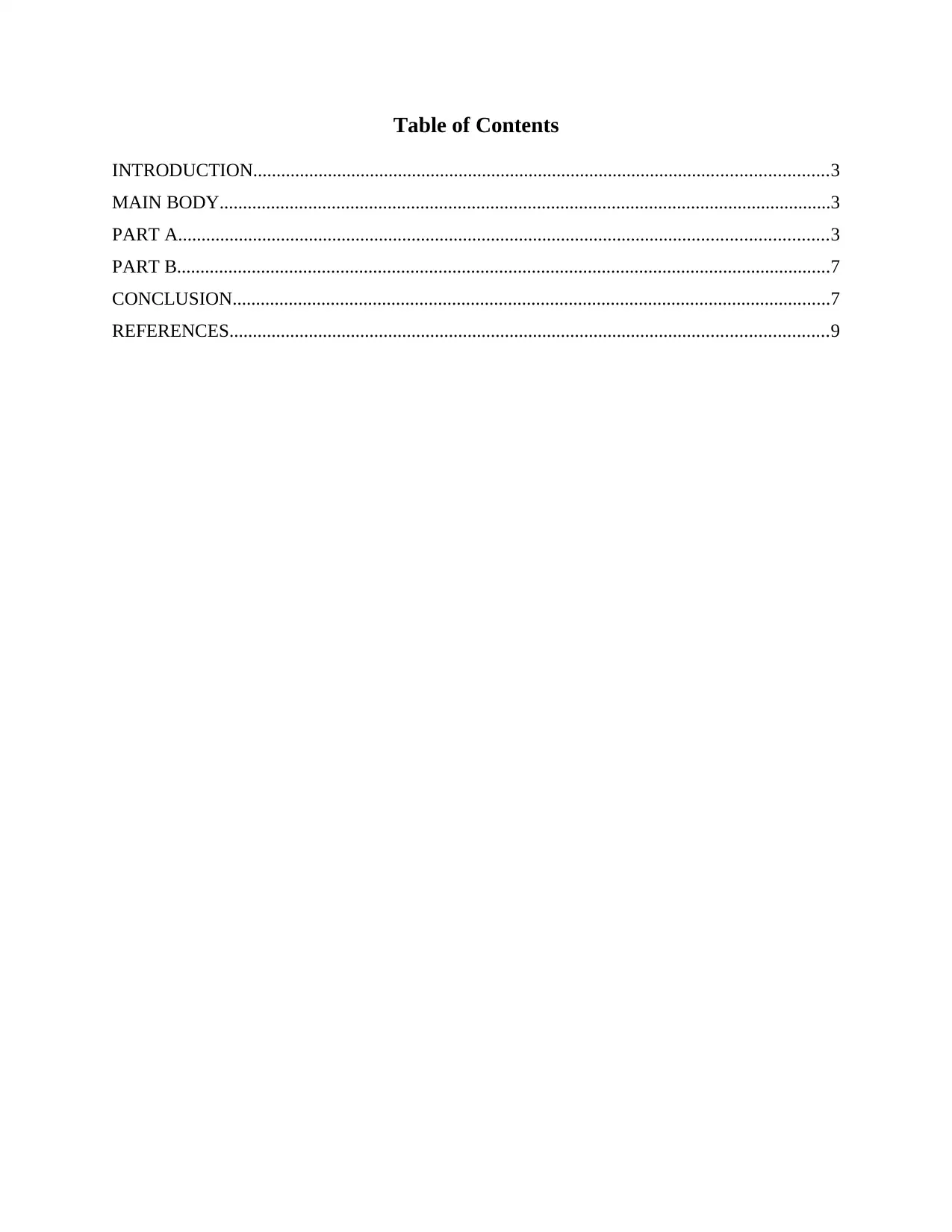
Table of Contents
INTRODUCTION...........................................................................................................................3
MAIN BODY...................................................................................................................................3
PART A...........................................................................................................................................3
PART B............................................................................................................................................7
CONCLUSION................................................................................................................................7
REFERENCES................................................................................................................................9
INTRODUCTION...........................................................................................................................3
MAIN BODY...................................................................................................................................3
PART A...........................................................................................................................................3
PART B............................................................................................................................................7
CONCLUSION................................................................................................................................7
REFERENCES................................................................................................................................9

INTRODUCTION
Organisational culture refers to the understanding of the members and community that
shares in common and also consists of the basic set of values, beliefs, ideas, perceptions, code of
conduct that have to be follow in the organisation. This combine set of these values and norms
refer as the organisational culture. This essay will describe the elements of strong organisational
culture. This will also explain the role of leaders to ensure the strong organisational culture as
well as an inclusive and multinational organisation. Further this essay will include the
recommendation for strong organisational culture. This report of essay will include the reflection
on the Google company ant its organisational culture and how management and leaders
influenced or failed to influence in the organisation.
MAIN BODY
PART A
There are many essential elements of the organisational culture such as organisational
norms, values, communication and many more that help to run the organisation smoothly and set
the culture I the organisation. These are as follows :
Organisational values, that reflect to the what is important to the organisation. These
values may be the guidelines, principles of the organisation that set the values in the organisation
(Driskill, 2018). Core values of the organisation may be described on the websites of the
organisation. Like an organisation could stated that their core values are humour, integrity,
creativity, dedication and mutual respect, kindness and contribution to the society. These values
are set for the employees of the organisation what they expect from them to behave in the
organisation. These values are shared behaviours, mindset and languages to achieve the mission
of the organisation.
Another element of the organisational culture is organisational beliefs, that are the part of
the organisation's culture and the best way to achievement of the set goals of the organisation.
Such as increasing productivity, job motivation. This beliefs of the company are set to be for the
members of the company that they follow and work on it to increase the productivity and other
desired goals. Company's beliefs help the employees, leaders and managers to set their goals and
give the employees to follow it and try to achieve overall goal of the company (Elsbach and
Stigliani, 2018).
Organisational culture refers to the understanding of the members and community that
shares in common and also consists of the basic set of values, beliefs, ideas, perceptions, code of
conduct that have to be follow in the organisation. This combine set of these values and norms
refer as the organisational culture. This essay will describe the elements of strong organisational
culture. This will also explain the role of leaders to ensure the strong organisational culture as
well as an inclusive and multinational organisation. Further this essay will include the
recommendation for strong organisational culture. This report of essay will include the reflection
on the Google company ant its organisational culture and how management and leaders
influenced or failed to influence in the organisation.
MAIN BODY
PART A
There are many essential elements of the organisational culture such as organisational
norms, values, communication and many more that help to run the organisation smoothly and set
the culture I the organisation. These are as follows :
Organisational values, that reflect to the what is important to the organisation. These
values may be the guidelines, principles of the organisation that set the values in the organisation
(Driskill, 2018). Core values of the organisation may be described on the websites of the
organisation. Like an organisation could stated that their core values are humour, integrity,
creativity, dedication and mutual respect, kindness and contribution to the society. These values
are set for the employees of the organisation what they expect from them to behave in the
organisation. These values are shared behaviours, mindset and languages to achieve the mission
of the organisation.
Another element of the organisational culture is organisational beliefs, that are the part of
the organisation's culture and the best way to achievement of the set goals of the organisation.
Such as increasing productivity, job motivation. This beliefs of the company are set to be for the
members of the company that they follow and work on it to increase the productivity and other
desired goals. Company's beliefs help the employees, leaders and managers to set their goals and
give the employees to follow it and try to achieve overall goal of the company (Elsbach and
Stigliani, 2018).
⊘ This is a preview!⊘
Do you want full access?
Subscribe today to unlock all pages.

Trusted by 1+ million students worldwide
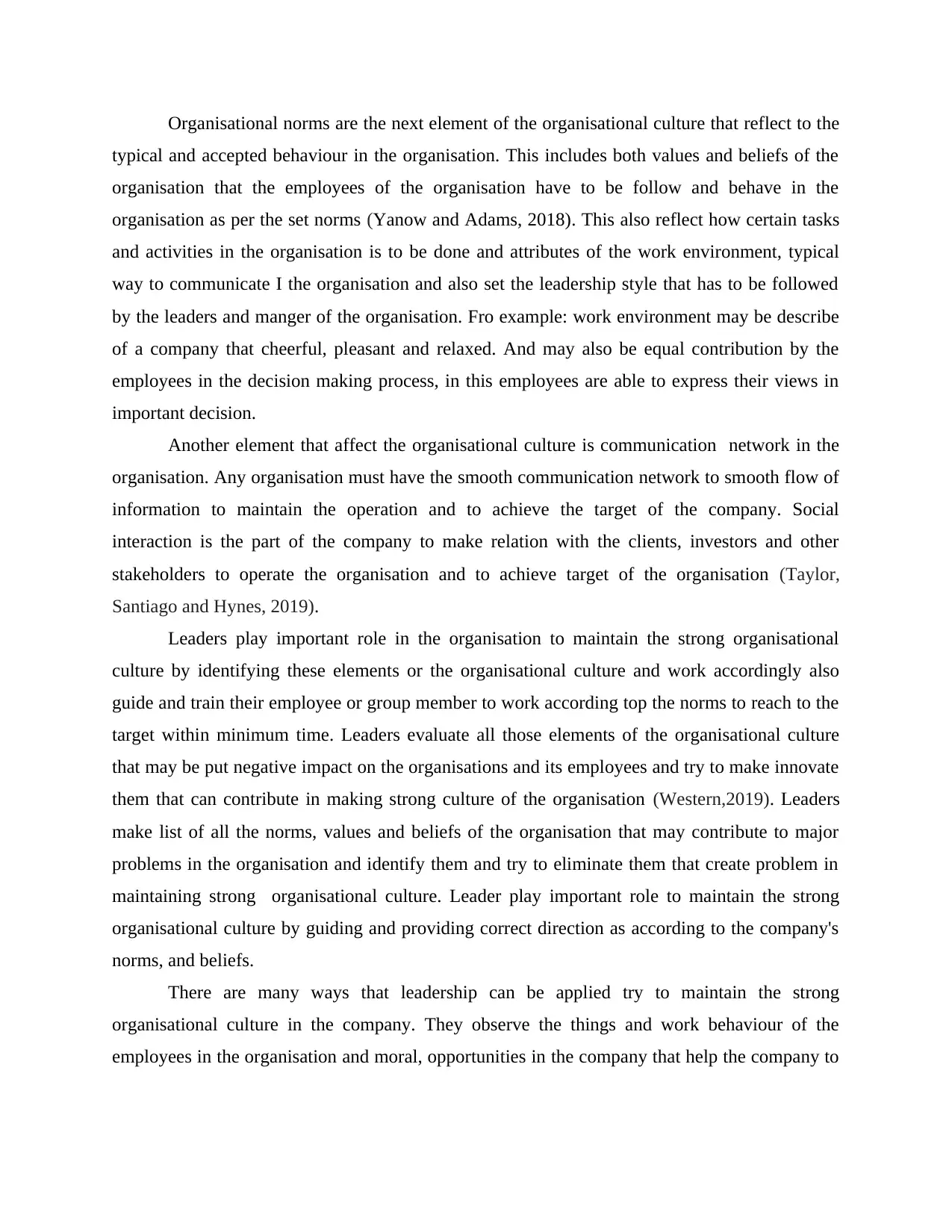
Organisational norms are the next element of the organisational culture that reflect to the
typical and accepted behaviour in the organisation. This includes both values and beliefs of the
organisation that the employees of the organisation have to be follow and behave in the
organisation as per the set norms (Yanow and Adams, 2018). This also reflect how certain tasks
and activities in the organisation is to be done and attributes of the work environment, typical
way to communicate I the organisation and also set the leadership style that has to be followed
by the leaders and manger of the organisation. Fro example: work environment may be describe
of a company that cheerful, pleasant and relaxed. And may also be equal contribution by the
employees in the decision making process, in this employees are able to express their views in
important decision.
Another element that affect the organisational culture is communication network in the
organisation. Any organisation must have the smooth communication network to smooth flow of
information to maintain the operation and to achieve the target of the company. Social
interaction is the part of the company to make relation with the clients, investors and other
stakeholders to operate the organisation and to achieve target of the organisation (Taylor,
Santiago and Hynes, 2019).
Leaders play important role in the organisation to maintain the strong organisational
culture by identifying these elements or the organisational culture and work accordingly also
guide and train their employee or group member to work according top the norms to reach to the
target within minimum time. Leaders evaluate all those elements of the organisational culture
that may be put negative impact on the organisations and its employees and try to make innovate
them that can contribute in making strong culture of the organisation (Western,2019). Leaders
make list of all the norms, values and beliefs of the organisation that may contribute to major
problems in the organisation and identify them and try to eliminate them that create problem in
maintaining strong organisational culture. Leader play important role to maintain the strong
organisational culture by guiding and providing correct direction as according to the company's
norms, and beliefs.
There are many ways that leadership can be applied try to maintain the strong
organisational culture in the company. They observe the things and work behaviour of the
employees in the organisation and moral, opportunities in the company that help the company to
typical and accepted behaviour in the organisation. This includes both values and beliefs of the
organisation that the employees of the organisation have to be follow and behave in the
organisation as per the set norms (Yanow and Adams, 2018). This also reflect how certain tasks
and activities in the organisation is to be done and attributes of the work environment, typical
way to communicate I the organisation and also set the leadership style that has to be followed
by the leaders and manger of the organisation. Fro example: work environment may be describe
of a company that cheerful, pleasant and relaxed. And may also be equal contribution by the
employees in the decision making process, in this employees are able to express their views in
important decision.
Another element that affect the organisational culture is communication network in the
organisation. Any organisation must have the smooth communication network to smooth flow of
information to maintain the operation and to achieve the target of the company. Social
interaction is the part of the company to make relation with the clients, investors and other
stakeholders to operate the organisation and to achieve target of the organisation (Taylor,
Santiago and Hynes, 2019).
Leaders play important role in the organisation to maintain the strong organisational
culture by identifying these elements or the organisational culture and work accordingly also
guide and train their employee or group member to work according top the norms to reach to the
target within minimum time. Leaders evaluate all those elements of the organisational culture
that may be put negative impact on the organisations and its employees and try to make innovate
them that can contribute in making strong culture of the organisation (Western,2019). Leaders
make list of all the norms, values and beliefs of the organisation that may contribute to major
problems in the organisation and identify them and try to eliminate them that create problem in
maintaining strong organisational culture. Leader play important role to maintain the strong
organisational culture by guiding and providing correct direction as according to the company's
norms, and beliefs.
There are many ways that leadership can be applied try to maintain the strong
organisational culture in the company. They observe the things and work behaviour of the
employees in the organisation and moral, opportunities in the company that help the company to
Paraphrase This Document
Need a fresh take? Get an instant paraphrase of this document with our AI Paraphraser
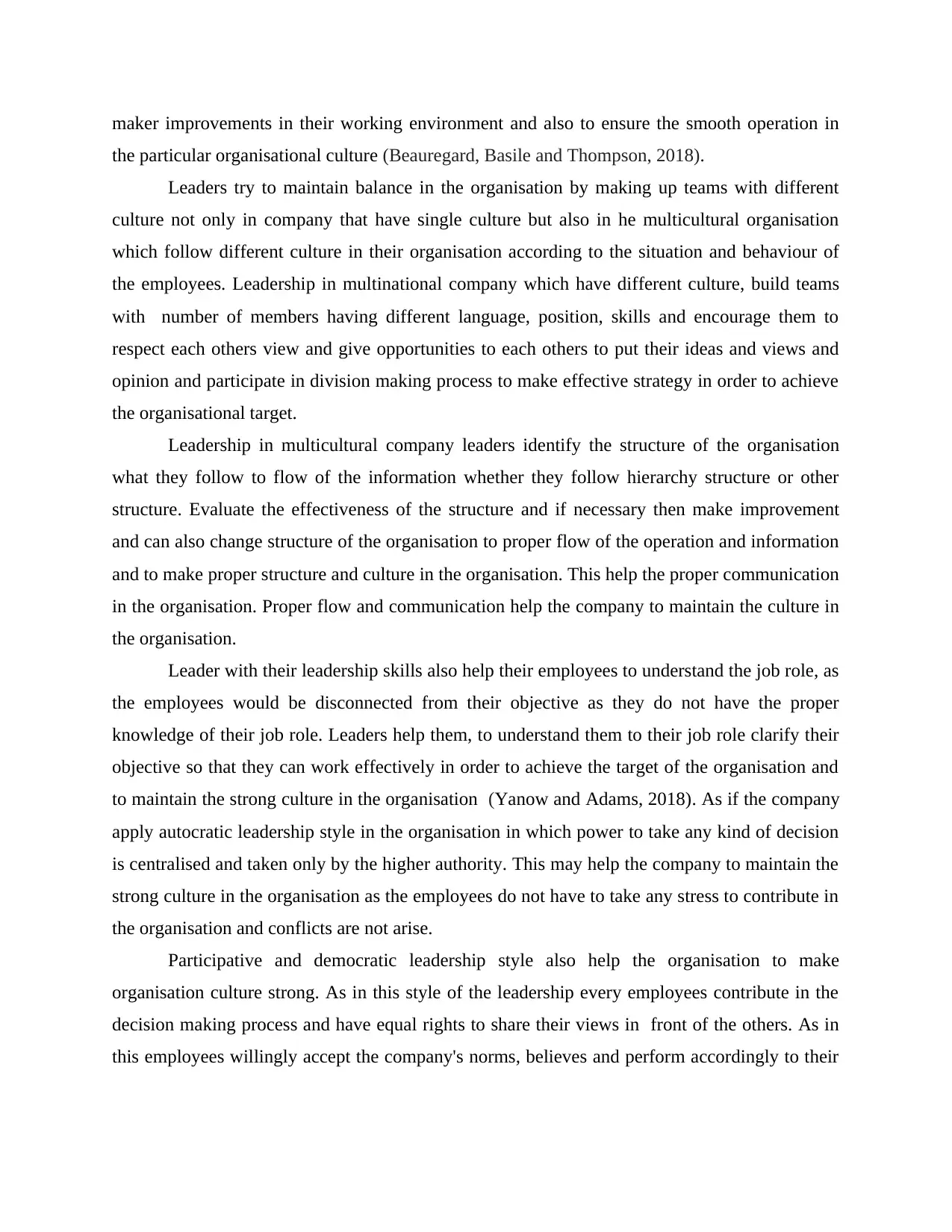
maker improvements in their working environment and also to ensure the smooth operation in
the particular organisational culture (Beauregard, Basile and Thompson, 2018).
Leaders try to maintain balance in the organisation by making up teams with different
culture not only in company that have single culture but also in he multicultural organisation
which follow different culture in their organisation according to the situation and behaviour of
the employees. Leadership in multinational company which have different culture, build teams
with number of members having different language, position, skills and encourage them to
respect each others view and give opportunities to each others to put their ideas and views and
opinion and participate in division making process to make effective strategy in order to achieve
the organisational target.
Leadership in multicultural company leaders identify the structure of the organisation
what they follow to flow of the information whether they follow hierarchy structure or other
structure. Evaluate the effectiveness of the structure and if necessary then make improvement
and can also change structure of the organisation to proper flow of the operation and information
and to make proper structure and culture in the organisation. This help the proper communication
in the organisation. Proper flow and communication help the company to maintain the culture in
the organisation.
Leader with their leadership skills also help their employees to understand the job role, as
the employees would be disconnected from their objective as they do not have the proper
knowledge of their job role. Leaders help them, to understand them to their job role clarify their
objective so that they can work effectively in order to achieve the target of the organisation and
to maintain the strong culture in the organisation (Yanow and Adams, 2018). As if the company
apply autocratic leadership style in the organisation in which power to take any kind of decision
is centralised and taken only by the higher authority. This may help the company to maintain the
strong culture in the organisation as the employees do not have to take any stress to contribute in
the organisation and conflicts are not arise.
Participative and democratic leadership style also help the organisation to make
organisation culture strong. As in this style of the leadership every employees contribute in the
decision making process and have equal rights to share their views in front of the others. As in
this employees willingly accept the company's norms, believes and perform accordingly to their
the particular organisational culture (Beauregard, Basile and Thompson, 2018).
Leaders try to maintain balance in the organisation by making up teams with different
culture not only in company that have single culture but also in he multicultural organisation
which follow different culture in their organisation according to the situation and behaviour of
the employees. Leadership in multinational company which have different culture, build teams
with number of members having different language, position, skills and encourage them to
respect each others view and give opportunities to each others to put their ideas and views and
opinion and participate in division making process to make effective strategy in order to achieve
the organisational target.
Leadership in multicultural company leaders identify the structure of the organisation
what they follow to flow of the information whether they follow hierarchy structure or other
structure. Evaluate the effectiveness of the structure and if necessary then make improvement
and can also change structure of the organisation to proper flow of the operation and information
and to make proper structure and culture in the organisation. This help the proper communication
in the organisation. Proper flow and communication help the company to maintain the culture in
the organisation.
Leader with their leadership skills also help their employees to understand the job role, as
the employees would be disconnected from their objective as they do not have the proper
knowledge of their job role. Leaders help them, to understand them to their job role clarify their
objective so that they can work effectively in order to achieve the target of the organisation and
to maintain the strong culture in the organisation (Yanow and Adams, 2018). As if the company
apply autocratic leadership style in the organisation in which power to take any kind of decision
is centralised and taken only by the higher authority. This may help the company to maintain the
strong culture in the organisation as the employees do not have to take any stress to contribute in
the organisation and conflicts are not arise.
Participative and democratic leadership style also help the organisation to make
organisation culture strong. As in this style of the leadership every employees contribute in the
decision making process and have equal rights to share their views in front of the others. As in
this employees willingly accept the company's norms, believes and perform accordingly to their

shared beliefs. So the employees do not create problem in the organisation and do not deny to
follow the organisational culture and maintain strong culture in the organisation.
Free rein leadership as in this avoid the power and responsibilities from the leaders and
they give it to the employees to take all the decision related to their work and set their own goals
and target to achieve it. In this workers have the responsibilities to take effective decision and to
achieve the target as within the minimum time. This help the organisation and multicultural
organisation to maintain its organisational culture by giving them to make decision as according
to them. This condition not be created conflicts and any problem with the management and
leaders.
An organisation can apply the Charles Handy's organisational cultural model to
maintain strong organisational culture in the organisation. Handy describe the four types of
culture in the organisation to follow and create strong culture in the organisation as according to
the employees that help the company to achieve its goal (KANE‐URRABAZO, 2016)
.
Power culture is which, power of taking decision remain in the hand of the upper
authority, employee do not have any rights to share their views and take decision. Only they have
to follow direction and order of their higher authority. They are the most important people of the
organisation who take all the decision and responsibilities to operation and give orders to the
employee to done their work within time and achieve target.
Another is Task culture, is formed to achieve the target only. There are some companies
which follow this kind of culture in their organisation, this is make to solve the critical problem
in he organisation. In this individuals with common interest and specialisation come together to
form a team and solve a problem or to accomplish the task. This may be help the organisation to
building strong culture in organisation as to concentrate on performing task and to achieve the
target of the company. Employees have clear vision and understanding of their job role to
perform and achieve target (Beauregard, Basile and Thompson, 2018).
Another culture which is Person culture that an organisation can apply in their company
to perform task to obtain the said target. In this culture people of of the organisation are most
valuable and important to the company as compared to the organisation. This can also help the
organisation to maintain its culture whether it is single cultural organisation or multicultural
organisation. As the employees feel that they are important for the organisation they give their
follow the organisational culture and maintain strong culture in the organisation.
Free rein leadership as in this avoid the power and responsibilities from the leaders and
they give it to the employees to take all the decision related to their work and set their own goals
and target to achieve it. In this workers have the responsibilities to take effective decision and to
achieve the target as within the minimum time. This help the organisation and multicultural
organisation to maintain its organisational culture by giving them to make decision as according
to them. This condition not be created conflicts and any problem with the management and
leaders.
An organisation can apply the Charles Handy's organisational cultural model to
maintain strong organisational culture in the organisation. Handy describe the four types of
culture in the organisation to follow and create strong culture in the organisation as according to
the employees that help the company to achieve its goal (KANE‐URRABAZO, 2016)
.
Power culture is which, power of taking decision remain in the hand of the upper
authority, employee do not have any rights to share their views and take decision. Only they have
to follow direction and order of their higher authority. They are the most important people of the
organisation who take all the decision and responsibilities to operation and give orders to the
employee to done their work within time and achieve target.
Another is Task culture, is formed to achieve the target only. There are some companies
which follow this kind of culture in their organisation, this is make to solve the critical problem
in he organisation. In this individuals with common interest and specialisation come together to
form a team and solve a problem or to accomplish the task. This may be help the organisation to
building strong culture in organisation as to concentrate on performing task and to achieve the
target of the company. Employees have clear vision and understanding of their job role to
perform and achieve target (Beauregard, Basile and Thompson, 2018).
Another culture which is Person culture that an organisation can apply in their company
to perform task to obtain the said target. In this culture people of of the organisation are most
valuable and important to the company as compared to the organisation. This can also help the
organisation to maintain its culture whether it is single cultural organisation or multicultural
organisation. As the employees feel that they are important for the organisation they give their
⊘ This is a preview!⊘
Do you want full access?
Subscribe today to unlock all pages.

Trusted by 1+ million students worldwide
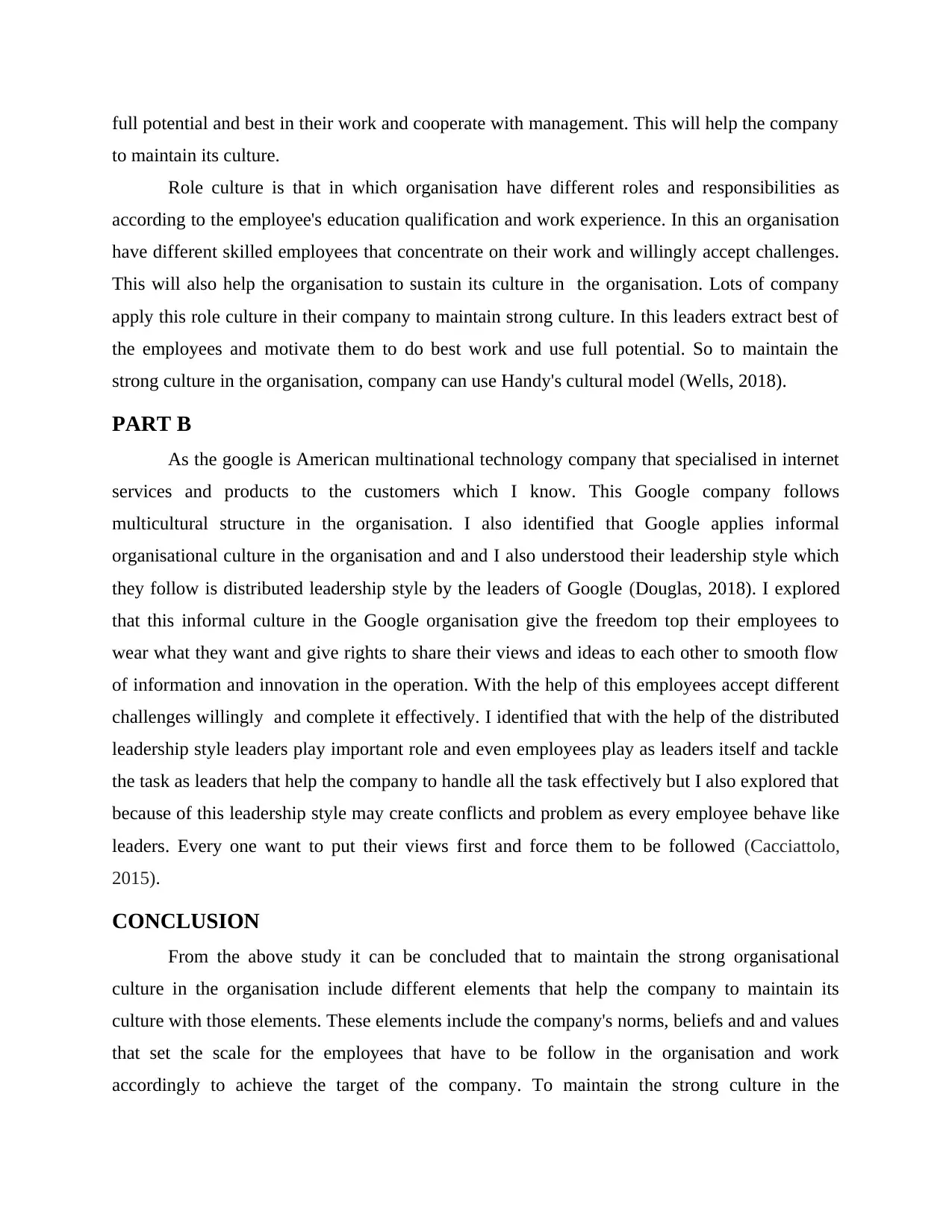
full potential and best in their work and cooperate with management. This will help the company
to maintain its culture.
Role culture is that in which organisation have different roles and responsibilities as
according to the employee's education qualification and work experience. In this an organisation
have different skilled employees that concentrate on their work and willingly accept challenges.
This will also help the organisation to sustain its culture in the organisation. Lots of company
apply this role culture in their company to maintain strong culture. In this leaders extract best of
the employees and motivate them to do best work and use full potential. So to maintain the
strong culture in the organisation, company can use Handy's cultural model (Wells, 2018).
PART B
As the google is American multinational technology company that specialised in internet
services and products to the customers which I know. This Google company follows
multicultural structure in the organisation. I also identified that Google applies informal
organisational culture in the organisation and and I also understood their leadership style which
they follow is distributed leadership style by the leaders of Google (Douglas, 2018). I explored
that this informal culture in the Google organisation give the freedom top their employees to
wear what they want and give rights to share their views and ideas to each other to smooth flow
of information and innovation in the operation. With the help of this employees accept different
challenges willingly and complete it effectively. I identified that with the help of the distributed
leadership style leaders play important role and even employees play as leaders itself and tackle
the task as leaders that help the company to handle all the task effectively but I also explored that
because of this leadership style may create conflicts and problem as every employee behave like
leaders. Every one want to put their views first and force them to be followed (Cacciattolo,
2015).
CONCLUSION
From the above study it can be concluded that to maintain the strong organisational
culture in the organisation include different elements that help the company to maintain its
culture with those elements. These elements include the company's norms, beliefs and and values
that set the scale for the employees that have to be follow in the organisation and work
accordingly to achieve the target of the company. To maintain the strong culture in the
to maintain its culture.
Role culture is that in which organisation have different roles and responsibilities as
according to the employee's education qualification and work experience. In this an organisation
have different skilled employees that concentrate on their work and willingly accept challenges.
This will also help the organisation to sustain its culture in the organisation. Lots of company
apply this role culture in their company to maintain strong culture. In this leaders extract best of
the employees and motivate them to do best work and use full potential. So to maintain the
strong culture in the organisation, company can use Handy's cultural model (Wells, 2018).
PART B
As the google is American multinational technology company that specialised in internet
services and products to the customers which I know. This Google company follows
multicultural structure in the organisation. I also identified that Google applies informal
organisational culture in the organisation and and I also understood their leadership style which
they follow is distributed leadership style by the leaders of Google (Douglas, 2018). I explored
that this informal culture in the Google organisation give the freedom top their employees to
wear what they want and give rights to share their views and ideas to each other to smooth flow
of information and innovation in the operation. With the help of this employees accept different
challenges willingly and complete it effectively. I identified that with the help of the distributed
leadership style leaders play important role and even employees play as leaders itself and tackle
the task as leaders that help the company to handle all the task effectively but I also explored that
because of this leadership style may create conflicts and problem as every employee behave like
leaders. Every one want to put their views first and force them to be followed (Cacciattolo,
2015).
CONCLUSION
From the above study it can be concluded that to maintain the strong organisational
culture in the organisation include different elements that help the company to maintain its
culture with those elements. These elements include the company's norms, beliefs and and values
that set the scale for the employees that have to be follow in the organisation and work
accordingly to achieve the target of the company. To maintain the strong culture in the
Paraphrase This Document
Need a fresh take? Get an instant paraphrase of this document with our AI Paraphraser

organisation different leadership style help the company to smooth flow of the culture and to
fulfil the target of the company in the direction and guidance of the leaders. This also concluded
from the recommendation that company can apply Handy's cultural model to smooth running of
the culture and to maintain the strong culture in the organisation.
fulfil the target of the company in the direction and guidance of the leaders. This also concluded
from the recommendation that company can apply Handy's cultural model to smooth running of
the culture and to maintain the strong culture in the organisation.
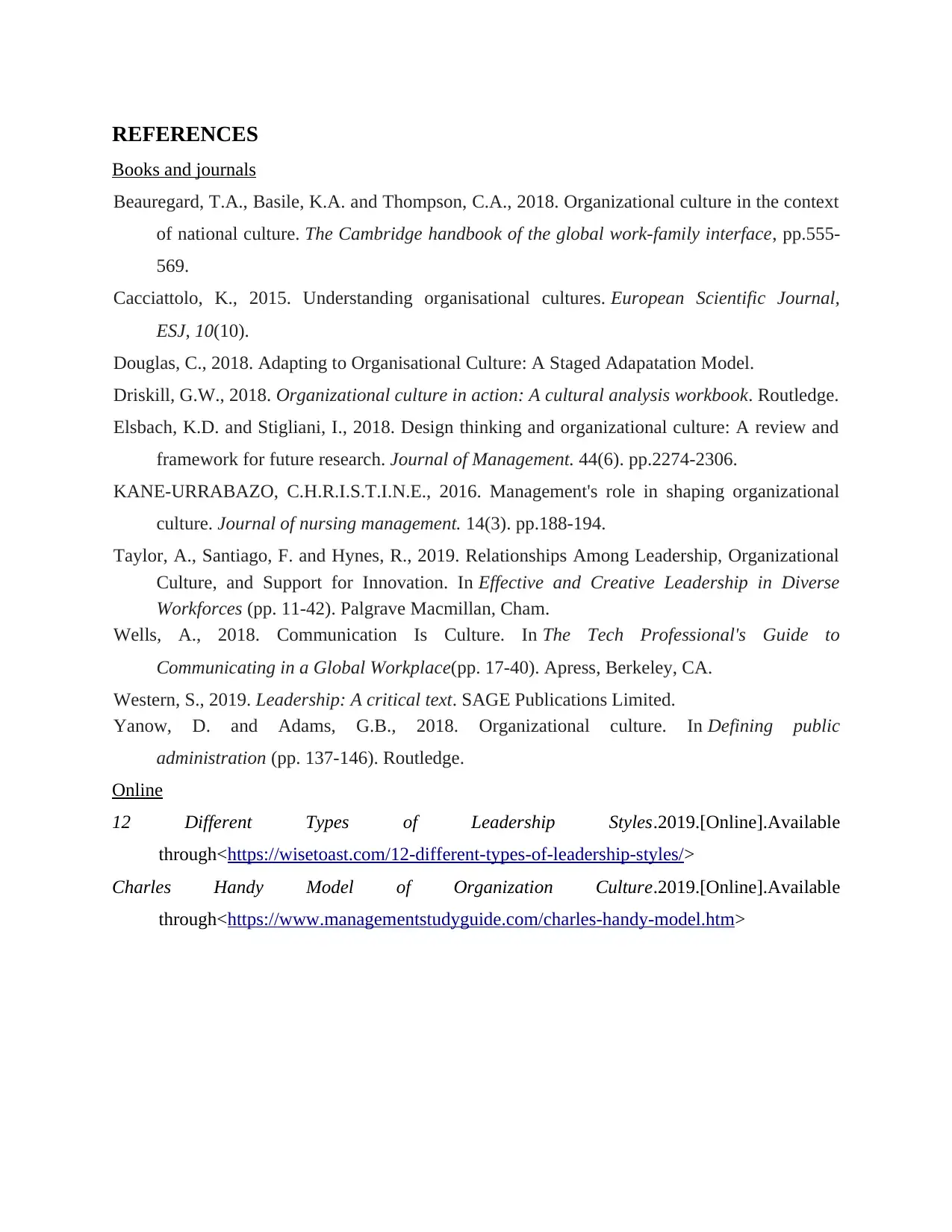
REFERENCES
Books and journals
Beauregard, T.A., Basile, K.A. and Thompson, C.A., 2018. Organizational culture in the context
of national culture. The Cambridge handbook of the global work-family interface, pp.555-
569.
Cacciattolo, K., 2015. Understanding organisational cultures. European Scientific Journal,
ESJ, 10(10).
Douglas, C., 2018. Adapting to Organisational Culture: A Staged Adapatation Model.
Driskill, G.W., 2018. Organizational culture in action: A cultural analysis workbook. Routledge.
Elsbach, K.D. and Stigliani, I., 2018. Design thinking and organizational culture: A review and
framework for future research. Journal of Management. 44(6). pp.2274-2306.
KANE‐URRABAZO, C.H.R.I.S.T.I.N.E., 2016. Management's role in shaping organizational
culture. Journal of nursing management. 14(3). pp.188-194.
Taylor, A., Santiago, F. and Hynes, R., 2019. Relationships Among Leadership, Organizational
Culture, and Support for Innovation. In Effective and Creative Leadership in Diverse
Workforces (pp. 11-42). Palgrave Macmillan, Cham.
Wells, A., 2018. Communication Is Culture. In The Tech Professional's Guide to
Communicating in a Global Workplace(pp. 17-40). Apress, Berkeley, CA.
Western, S., 2019. Leadership: A critical text. SAGE Publications Limited.
Yanow, D. and Adams, G.B., 2018. Organizational culture. In Defining public
administration (pp. 137-146). Routledge.
Online
12 Different Types of Leadership Styles.2019.[Online].Available
through<https://wisetoast.com/12-different-types-of-leadership-styles/>
Charles Handy Model of Organization Culture.2019.[Online].Available
through<https://www.managementstudyguide.com/charles-handy-model.htm>
Books and journals
Beauregard, T.A., Basile, K.A. and Thompson, C.A., 2018. Organizational culture in the context
of national culture. The Cambridge handbook of the global work-family interface, pp.555-
569.
Cacciattolo, K., 2015. Understanding organisational cultures. European Scientific Journal,
ESJ, 10(10).
Douglas, C., 2018. Adapting to Organisational Culture: A Staged Adapatation Model.
Driskill, G.W., 2018. Organizational culture in action: A cultural analysis workbook. Routledge.
Elsbach, K.D. and Stigliani, I., 2018. Design thinking and organizational culture: A review and
framework for future research. Journal of Management. 44(6). pp.2274-2306.
KANE‐URRABAZO, C.H.R.I.S.T.I.N.E., 2016. Management's role in shaping organizational
culture. Journal of nursing management. 14(3). pp.188-194.
Taylor, A., Santiago, F. and Hynes, R., 2019. Relationships Among Leadership, Organizational
Culture, and Support for Innovation. In Effective and Creative Leadership in Diverse
Workforces (pp. 11-42). Palgrave Macmillan, Cham.
Wells, A., 2018. Communication Is Culture. In The Tech Professional's Guide to
Communicating in a Global Workplace(pp. 17-40). Apress, Berkeley, CA.
Western, S., 2019. Leadership: A critical text. SAGE Publications Limited.
Yanow, D. and Adams, G.B., 2018. Organizational culture. In Defining public
administration (pp. 137-146). Routledge.
Online
12 Different Types of Leadership Styles.2019.[Online].Available
through<https://wisetoast.com/12-different-types-of-leadership-styles/>
Charles Handy Model of Organization Culture.2019.[Online].Available
through<https://www.managementstudyguide.com/charles-handy-model.htm>
⊘ This is a preview!⊘
Do you want full access?
Subscribe today to unlock all pages.

Trusted by 1+ million students worldwide
1 out of 9
Related Documents
Your All-in-One AI-Powered Toolkit for Academic Success.
+13062052269
info@desklib.com
Available 24*7 on WhatsApp / Email
![[object Object]](/_next/static/media/star-bottom.7253800d.svg)
Unlock your academic potential
Copyright © 2020–2025 A2Z Services. All Rights Reserved. Developed and managed by ZUCOL.


